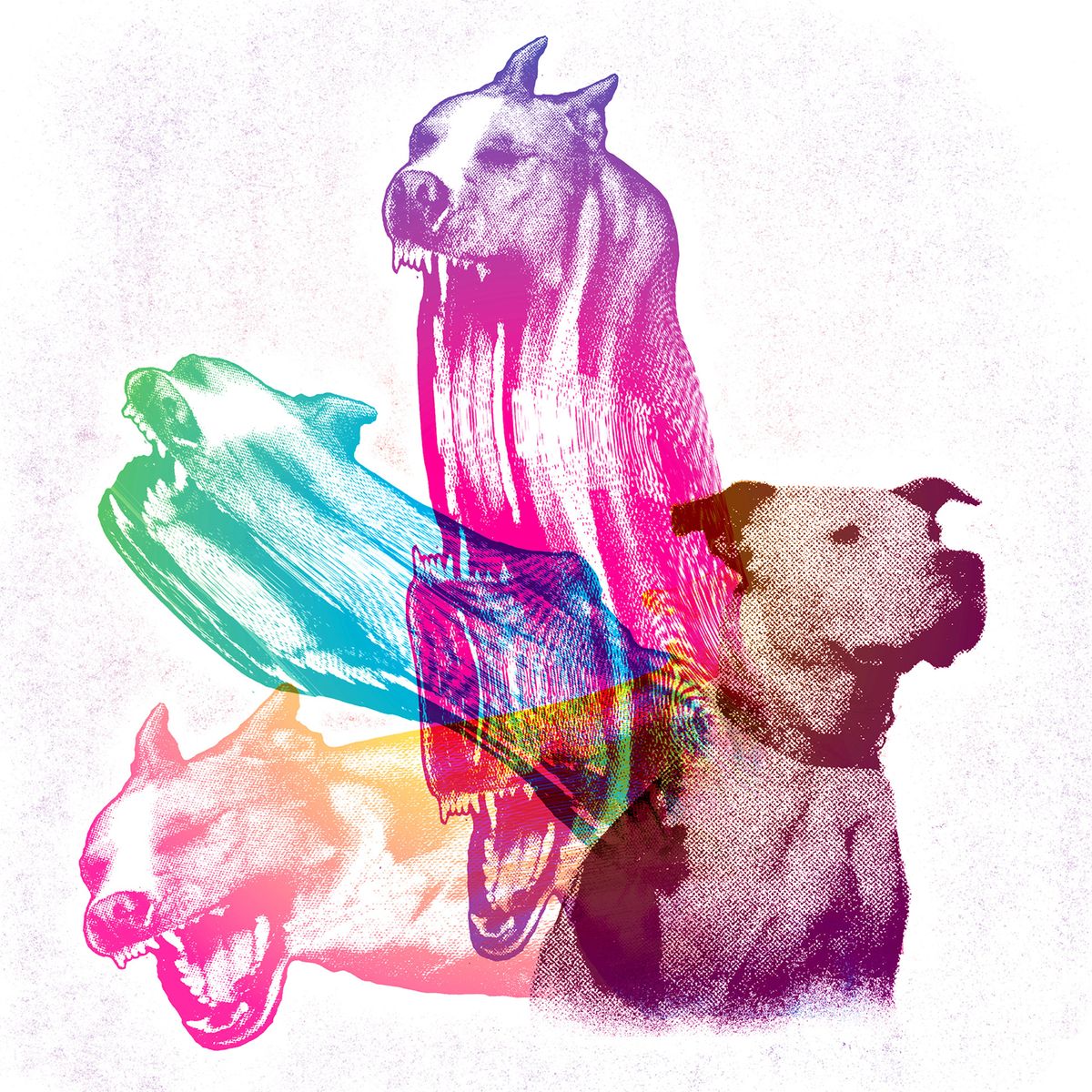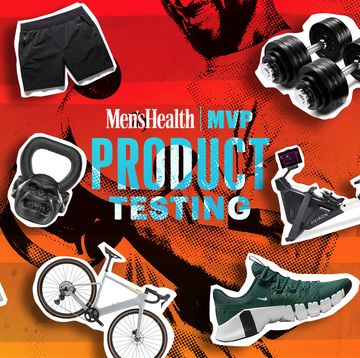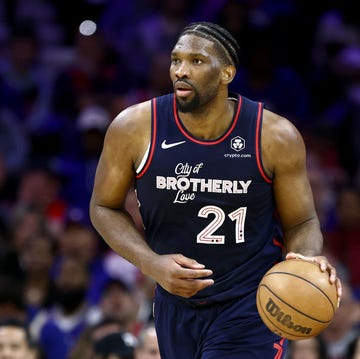TEN MINUTES BEFORE my dog tried to kill me, we went on a peaceful walk. Rollie, a nine-year-old, 80-pound pit-bull mix with coconut-white fur and a ginger spot on his left eye, strolled calmly by my side under a bright evening sky. When we returned home, I untethered his leash and sped upstairs to see my wife, Eve, who was tapping away at a presentation on her laptop. Rollie rolled into a ball by her feet. I went to grab my gear for my daily run.
As I approached Eve, I clenched my running clothes in my left hand. Rollie growled at me. Gums. Teeth. His eyes scoped on me, his body tense and pointed. I whispered, “Eve, can you grab the dog?”
Then Rollie launched toward me, hammerlocking his jaws into my right forearm, gnashing it like a bone he found in the yard. Growling. Gurgling. I swung a left jab into his head—thud—Rollie was unfazed. He thrashed my arm and burrowed his teeth deeper into my flesh. Time slowed, and for what was the longest minute of my life, I felt like I was floating above my body, watching it fall limp like a Ziploc bag of chicken parts in marinade.
Eve pried his jaws open with both of her hands, but the releasing force threw her backward. Rollie lunged forward again and chomped into my left wrist. My mind flashed back to five years earlier, when Rollie attacked another dog, clamping onto his throat. I dreaded that Rollie would move on to my jugular next.
“Rollie, stop!” yelled Eve as she grabbed him by the collar. He unlocked his jaws and sat obediently. Eve kicked the door shut as I ran down the stairs to survey my arms. My right arm revealed thick globs of pale-yellow exposed fat, torn muscle tissue, and bone. My punctured left wrist sprayed blood like a lawn sprinkler.
While crawling to the backyard, I left a trail of blood in my wake. My breath was shallow. My heart raced. I felt sleepy. I thought, If I lie here, I will bleed out.
I got up, then lurched through the house and out the front door for help. My neighbor was already on my porch—she must’ve heard the screams. “My dad is an EMT, so I know what to do,” she said, fashioning her sweatshirt into a tourniquet around my arm. Minutes later, an ambulance arrived. Eve stepped outside, and I felt relieved that she was unscathed.
“Put the dog down,” I told her. “Tonight.”
WHEN EVE AND I first met Rollie at the animal shelter, he was a sweet nine-month-old puppy. On our trial walk, he stopped to roll over in a patch of grass, revealing a smooth hairless belly—my favorite spot to pet. “He’s the one,” I told Eve. We adopted him and changed his original name, Sage, to Rollins, an ode to one of our favorite musicians, Henry Rollins.
But Rollie became protective of Eve, and after a few years, she couldn’t walk with him anymore. He’d bark and lunge at strangers, and once bit someone. We paid the doctor’s bill and hired trainers who gave us obedience exercises, which worked, because they involved treats, and Rollie was food-motivated. The trainers encouraged me to run with him.
On our runs, he’d look up at me with a big smile as his tongue flopped like a wind sock. When we stopped for a drink, people would laugh at the sight of a four-foot-tall dog standing and slurping water out of a fountain. For years, Rollie was my training buddy.
Then during the pandemic, something changed in Rollie. We were at home nonstop, and he didn’t want to be separated from Eve—ever. Six months before the attack, he was sitting in the backyard with Eve and growled at me when I approached him to go for a run. It broke my heart. We stopped running together, but that wasn’t enough. If Rollie spotted me in running clothes, his back hair would flare, and he’d slowly pace behind me in hunting mode. I started sneaking out of the garage to run. On the night of the attack, Rollie spotted my running clothes in my hand—and I guess that triggered him to attack me.
WHILE I SAT in the emergency room, a young doctor asked if I’d be willing to receive a blood transfusion, as I lost a significant amount of blood. “Yea, sure,” I responded, devoid of emotion. The doc, concerned over my condition, sat at my bedside, comforting me through small talk. Minutes later, we were interrupted by two police officers. “Your dog is going to be terminated,” said one of the cops, handing me a police report to sign. The severity of the situation sunk in—my bottom lip quivered, my eyes welled up.
The boyish doctor saw my tears and stood up to the two barrel-chested cops. “Guys, give him a fucking minute,” said the doc. It felt great to know a stranger could care so much.
I didn’t need the blood transfusion, but I did need reconstructive surgery, which was continually postponed. I wasn’t allowed to eat prior, so they confined me to a bed with an IV in my arm. My mind was a Michael Bay-style action montage of the attack, and I hit mute by mainlining as much morphine as the nurses would administer, for the next two days.
When I awoke from the surgery, my bandaged arm was bulbous and cartoony, like the Michelin Man’s. The surgeon explained that my right forearm was essentially ground into hamburger meat. They excavated unrepairable muscle tissue. Eighteen stitches in the right forearm, four stitches in the left wrist. No nerve damage, but full mobility of the right hand was in question. The surgeon handed me a little foam square to squeeze for physical therapy and a prescription for OxyContin for the pain. Addiction runs in my family. I ditched the script and kept the square.
My brush with death shattered me emotionally. In order to recover, I needed to make peace with Rollie, with Eve, and with myself. While I was on hiatus from work as my arm healed, my boss encouraged me to take extra time to heal mentally. The break forced me to confront my feelings. I saw Rollie’s ghost everywhere. I felt guilty for putting Eve through this mess. After all, I was the one who’d wanted the dog.
In the aftermath of the assault, I rehashed a lot of conflicting feelings. I missed the goofball that ran with me. But I hated the motherfucker that attacked me. I felt remorse for putting him down. These contradictory emotions made me feel embarrassed, even ashamed.
Confronting my emotions is not a strength of mine. I’m a child of the 1980s who grew up on action flicks starring Schwarzenegger, Snipes, and Stallone—guys who solved their problems with uppercuts and spin-kicks. Physicality was my go-to solution for emotional problems, and I ran every morning, sometimes to escape what bothered me. But I couldn’t run until my arm healed, so instead I walked, trying to make sense of the calamity. I’m an only child, not used to sharing my emotions, and while I thought I could resolve this situation on my own, I was wrong.
Upon returning from these walks, I poured out to Eve. I worried she’d judge my tangled emotions, but she witnessed my sensitive side, deepening our bond. We discussed Rollie over morning coffee, and that coffee became a ritual for us.
Later, I talked to Avi Klein, L.C.S.W., a New York–based psychotherapist and MH mental-health advisor. He told me that to overcome a traumatic event, it helps to confront all your emotions. “Emotion precedes cognition. If you’re open about what you’re feeling, then you can make sense of a situation.”
I also reached out to Richard Tedeschi, Ph.D., the executive director of the Boulder Crest Institute for Posttraumatic Growth, to help me figure out how to move on. “As human beings, we try to understand things and come up with explanations,” says Tedeschi. I gave Rollie loads of love, and he attacked me in return—I wanted to know what I did wrong. But as Tedeschi says, “In order to move forward, you have to live with ambiguity.” That’s not easy.
A year after the attack, I visited my parents down in North Carolina. While unpacking my car, Mom came to greet me, and I wept like a baby. “I’m a failure as a dog parent—I couldn’t save Rollie,” I told her. But mom built me back up. “You gave that dog a lot of love, and parenting teaches you unconditional love,” she said. “Even when shit happens.” That helped me understand that I didn’t waste my love on Rollie, and one day I could be loved by other dogs.
The attack also left me with a new fear of being attacked. Barking dogs rattled me, and when they stared at me, I tensed up. “It’s important to not avoid the things that scare you,” Klein told me. “That builds more anxiety-avoiding behaviors, which could require stronger solutions, like isolating yourself or abusing substances.”
I had the chance to face my fear head-on. While at a friend’s house, I stepped into a penned area with two Labradors and one golden retriever. My friends’ anxiety was palpable. But I petted the dogs; they licked my face. This was my first intimate interaction with dogs, and it quelled my fear that all dogs are violent. I’m still cautious around canines, but this moment helped me think positively about them again.
Mom was right: Shit happens—but that shit can be fertilizer if you forgive whoever wronged you, whether it’s a dog, a person, or just life. “An important step in reframing trauma as growth is to ask yourself what positive outcomes have resulted from the event,” says Tedeschi.
I still love Rollie, but I don’t ruminate on him daily. My perspective on work and life changed. Full mobility eventually returned to my hand. I even wrote a (somewhat adjacent) book Creative Endurance: 56 Rules for Overcoming Obstacles and Achieving Your Goals. I reframed the attack as a kind of mental trophy, and if I’m stressed about a deadline or a presentation, I remind myself the challenge pales in comparison with the obstacle I overcame. I now take time to slow down, to share long coffee breaks with Eve, and I share my feelings more. This tragedy made me more connected to other people as well—my neighbor, my boss, the doc at the hospital; so many came to my aid. I ask for help more often now. I’ve realized I don’t need to have all the answers.
This article originally appears in the March/April 2024 issue of Men’s Health.













